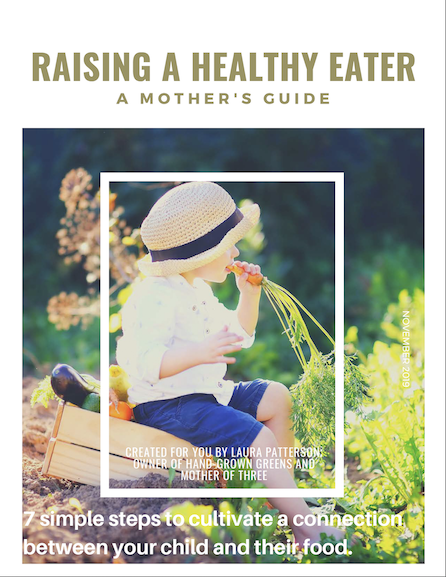From Yucky to Yummy in 7 actionable steps.
When you think about how to encourage your child to eat vegetables, you want to lay a healthy foundation right?
We want to help our kids develop a life-long healthy relationship with the food that nourishes them.
This all sounds very intellectual I know. And while it may resonate with you on that level, you may also be asking yourself; “yeah, but how do I get my kids to eat vegetables??”
Well my friend, I’m so glad you asked! Like you, I am in it!! I am Mom to a 6 year old, a 5 year old and a 2 year old. So believe me. I get that the struggle is real.
When your child flat out refuses to eat anything green… What do you do?
What should you do?
I want to give you 7 practical, actionable steps you can take to encourage your children to eat their vegetables, and better yet, actually get them excited about vegetables!!
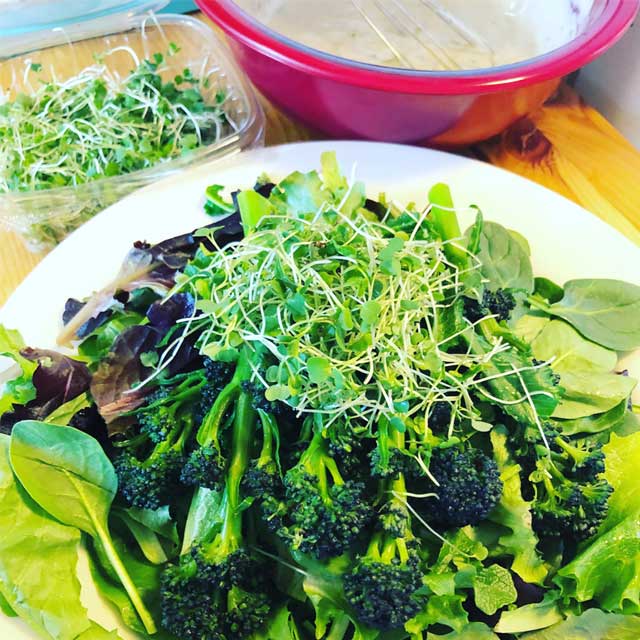
Love for veggies starts with a connection to the very earth they grow from.
It is critical that our kids develop a foundational understanding of where food comes from. This understanding comes from seeing firsthand how food is produced and better yet, participating in the process of growing food.
Less than 1% of kids today grow up on farms.
So, if you don’t have acres of land to cultivate, don’t worry. You are not alone.
This just means you have to be a little more intentional about teaching your kids the basics of where food comes from. Out of this connection will come a genuine appreciation for vegetables.
So if you are tired of the screwed up face and the emphatic “yuck!” uttered by your child when they see green on their plate…
Read on to discover 7 steps that will take your kids from “Yuck” to “Yum” and get them excited to eat their veggies!
Want to learn how to grow microgreens at home? I’ve put together a complete course especially for busy moms! Growing microgreens is easy, fun and takes up very little time & space. The rewards, though, are huge!
Set the example for healthy eating
Start by taking an honest look at yourself and your diet.
Our kids are extremely observant. If we are not making healthy food choices ourselves, our kids will notice.
If we are not setting the daily example, our kids will have a much harder time reconciling our words and our actions.
This is an important one!
Want to encourage your children to eat more vegetables? Show them how it’s done.
If you know you need to make some changes, stop making excuses and just do it. You deserve healthy food as much as your kids!
You too can learn how to be excited about eating your vegetables. Go on this journey with your kids!! Remember, healthy eating is about moderation, variety and balance.
Let your kids see you eating and snacking on veggies. Be aware of your body language and facial expressions. Sending positive cues to our kids around eating veggies will do wonders for them.
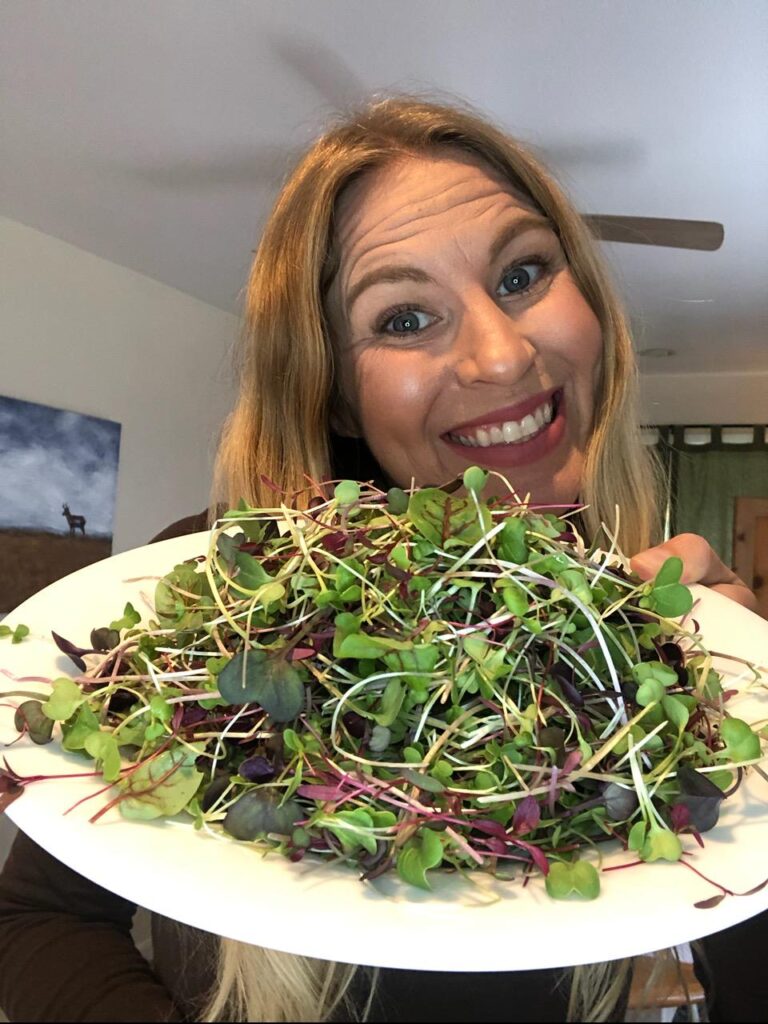
There are several ways you can practically model healthy eating:
- Keep a wide variety of veggies and healthy food stocked in your home.
- Prep veggies ahead of time so they are convenient to eat.
- Take the time to sit down and eat with your kids. Share the same meal or snack you are serving them.
- Include varied veggies in snacks and meals.
- Avoid multitasking while eating. Eat with purpose and intention.
Use positive messaging around vegetables
How you talk about food is another vital component in the messaging you are sending your kids about their own eating and relationship with food. Frame table talk in the positive.
Avoid threats or rewards around eating vegetables or other healthy foods.
As parents many of us have resorted to the “if your don’t eat your vegetables, you wont get a treat” kind of threats. Sound at all familiar?
This is not a guilt trip. We’ve all gone to some sort of embarrassing lengths at some point in time trying to get healthy food into our kids .
The problem is, these kind of threats or rewards frame healthy foods like vegetables in a negative light, as if they are something that must be choked down for reward.
I want more for my kids and I’m sure you do to.
I want to instill a love for healthy foods like vegetables.
If you are with me on this, it’s really important to be intentional about eliminating any kind of table talk that frames vegetables and other healthy foods as an obstacle to “the good stuff”.
Instead, talk about all the delicious flavors and textures you enjoy in what you are eating.
No matter how positive you are, there may be some vegetables that you just can’t sell your kids on. And that’s ok! We all have food preferences and that’s part of being human. Continue to offer these foods to your kids, understanding that preferences can change.

Explain about food preferences and be honest with them about some of your own. Encourage them to talk about their preferences, by giving them the language to do that.
For example, if your child says “I hate broccoli”, you can respond with “It sounds like you don’t prefer broccoli tonight”. This sets up the idea that preferences are not fixed.
You may also find it helpful to explain that sometimes we ALL eat our “less than favorite foods” because we know that eating a mix of different kinds of foods gives our body what it needs to be strong and healthy.
Help your kids cultivate an attitude of gratitude when it comes to healthy foods like vegetables.
Point out the connection between healthy foods leading to healthy bodies. This can be as simple as remarking how grateful you are that your healthy lunch has given you the energy you need to enjoy playing soccer. Take a moment to reflect on activities that bring your own kids joy.
Then think of how you can draw the connection between these activities and healthy foods. Healthy foods give us clear thinking, energy etc.
If your kids are very young, you can keep this very basic and generalized. As you kids get a bit older it may be helpful to be more specific.
Visit a Farm!
Very few kids are growing up on farms today. But, nearly all kids love farms. Capitalize on that excitement!
Explain to your kids that ALL food comes from farms. This is often a very novel idea to kids who are used to seeing food wrapped in neat packages on a store or pantry shelf. Kids need these core perspectives to develop a more complex relationship with food as the grow older. Lay the ground work now!
The best way to learn about where food comes from is to go to visit a local farm!
What better way to encourage your child to eat vegetables than to pick it fresh from the ground?
If you don’t know of any farms in your area, well it’s time to hop on google or your favorite search engine and discover what’s out there.
You can also check with your County’s Agricultural Department. Some farms may be open to the public, which is an easy way to start. But you can also be more creative. Try contacting the owners of small family farms near you. Ask if you can bring your family out to their farm for a visit.

Look into Community Supported Agriculture Programs (CSA) in your area. CSA’s provide an amazing opportunity to connect with local food.
CSA members are people in the community who pay a farm money upfront for season. In exchange, they get a weekly box of farm fresh produce. This program supports the farmer by providing needed capital, and a guaranteed sale. It also allows the farmer to share in the inevitable risk that comes with farming.
For example, some crops may do better or worse on a particular year due to weather. In a CSA model, the farmer is assured revenue despite factors out of his/her control. The CSA members benefit hugely by getting amazing, locally grown produce.
What’s more, as members, they are part of the farm! They have a real opportunity to build a connection with the people growing and raising their food and the land from which that food comes.
It’s a win-win!!
Time to do a little research and find out what CSA’s are in your area!

Photo from Jubilee Farm
Shop at a Farmers’s Market!
Farmer’s Markets are another way you can expose kids to healthy, locally raised and grown foods.
Market environments tend to have a festive energy about them which sends the message to our kids that healthy food is something to be celebrated, rather than endured.
Vegetables displays are abundant, impressive, and truly beautiful. It’s hard to not get excited walking around the tables and seeing so many other people happily buying the bounty!
Farmers themselves are usually the people selling their own goods. So you have an opportunity to get to know the very people who grew or raised the food that will be nourishing you family.
It’s pretty cool and another awesome opportunity to highlight this connection for your kids.
Make farmer’s market shopping a regular, weekly outing if possible. This will help you and your kids to build a rapport with your local farmers.
Ask questions and ask for suggestions! Encourage your kids to engage with the farmer’s by ask their own questions! You’ll see, it will get them excited and it’ll make it much easier to encourage your child to eat vegetables!
Take in the sights, sounds, and smells. Think about what yummy meals you can make with these fresh ingredients!

Plant a Garden
This may seem like a natural way of helping your kids develop a healthy connection with their food. However, for many the idea can be a little daunting. If you’ve never grown a garden before it can be overwhelming to know where to start.
Remember, a garden can be as elaborate or as simple as you have time and space for.
If you are new to gardening I recommend starting small. Raised beds are one option that allow for a very manageable garden space. The size of your raised bed can be scaled to fit your space, time and family size.
Pick vegetables, fruits and herbs to grow that do well in your climate and that are enjoyed by your family.
Involve your kids in every step of the process. Look through seed catalogues together and pick out seeds to purchase.

Participating in the growing process is a great way to encourage your child to eat vegetables.
Plan out your garden beds. Let your kids draw out the final plan. Start a family garden journal to keep records of what worked well and what didn’t.
Let your kids write or draw in the journal as they are able. This record will be priceless in seasons to come.
Involve your kids in gardening by including them in:
- preparing the beds,
- planting,
- weeding,
- watering and
- harvesting.
Kids love getting in the dirt. They are drawn to the realness of it. As a Mom, it makes my own heart so happy to see my kids connecting to the earth in this wholesome way.
Give your kids special garden responsibilities.
This will naturally lead them to feel more invested in the process, and subsequently more excited to eat what the garden produces.
If you need a little more garden guidance I have a great resource to recommend. Check Nicole Burke with gardenary.com
She is a wealth of knowledge when it comes to helping new gardeners in getting started. She has some great resources for experienced gardeners as well.
Grow Indoors
Want an easy and quick way to encourage your child to eat vegetables? Get them growing these amazing tiny greens!
Gardening is fantastic. But…for younger kids, not so well versed in delayed gratification, you may reap even more benefits from growing Microgreens in windowsill pots inside your home.
Microgreens are jam packed with concentrated levels of nutrition as well as flavor.
They are super simple to grow year round and they grow extremely quickly. Even the most impatient little one will enjoy growing microgreens as they change daily and can be ready to eat in as little as 7 days.
If you want more information about what Microgreens are, check out my blog post “What are Microgreens”.
As a mother of 3 small children, I have found growing microgreens at home to be the NUMBER ONE activity that get my kids excited to eat their vegetables.
Microgreens are young veggies and are so approachable to kids. They have tender textures, fresh flavors and beautiful colors. Kids just plain love ‘em! -especially when they are the ones who have grown them.
You have a chance to give your kids some autonomy here.
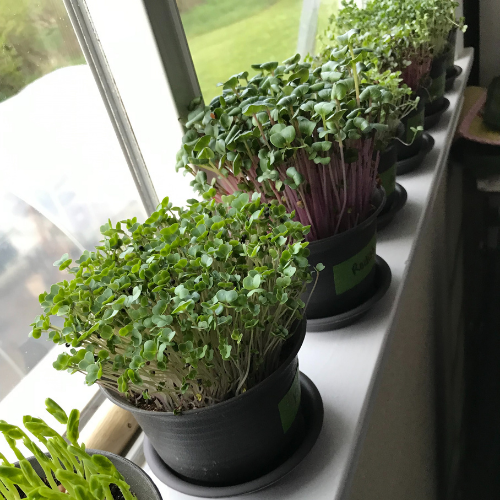
If you want your child get excited about eating veggies, let them grow their own microgreens.
If possible, let them complete the whole process, from selecting the seeds, to planting, watering and even harvesting.
Children as young as 3 can prepare a growing pot, sprinkle seeds and water the seeds. That’s all it takes. They can do this. So let them do it!
The power of ownership will transfer when it comes time to eat these nutrient dense little greens.
Microgreens could not be easier to incorporate into your family’s meals and snacks. Simply snip and add to your dish as a means of boosting flavor and nutrition.
No special recipes or meal planning needed.
If you are looking for more inspiration, check out my blogpost “Top 10 meal boosting ideas”.
Secret Mom trick- If you let your kids snip (why do kids love scissors?) their own microgreens it does wonders for empowering your child to choose to eat their little veggies.
Cutting their own microgreens and putting them on their plate is the grand finale. Its what they’ve been waiting for the whole growing cycle (all 7-10 days). They truly will be excited to to eat their greens!
I have seen the magic of this in my own house and its been a driving force in my business. I just have to share this little piece of magic with you!!
Involve your Kids in Meal Prep
Letting your kids help with meal planning and preparation is so key to getting them excited about what ends up on their plate.
Planing and preparing meals helps kids feel empowered. Plan out your meals and snacks for the week or the month and allow for input from your kids.
Find what fits your life.
Allow your kids to be part of choosing what your family eats. If meal plans work for you, go for it!
Find ways that your kids can voice their preferences. Get creative here! You know your child best. What will make them feel honored and heard?
When it comes time to prepare snacks and meals, meet your kids where they are at developmentally.
I believe even very young kids can be involved in meal prep.
Do you have a garden? Let your kids check to see what might be ready to harvest.
If your kids are growing microgreens have them be in charge or deciding if they are ready to be cut. When your kids are old enough, give them clean, safe scissors and allow them to snip!
Give them the reins as much as possible in the veggie department. Sure you can encourage your child to eat vegetables – but getting them to WANT to do it on their own is even better!
Budget extra time to make meals. Altering your time frame expectations will help you to change your mindset and enjoy this process with patience.
Turn cooking into an activity and a learning opportunity rather that a hurried task to get through.
Kids love washing veggies, peeling, slicing, mixing, arranging and plating. When you start thinking about it, you will see there are many ways to get your kids involved.
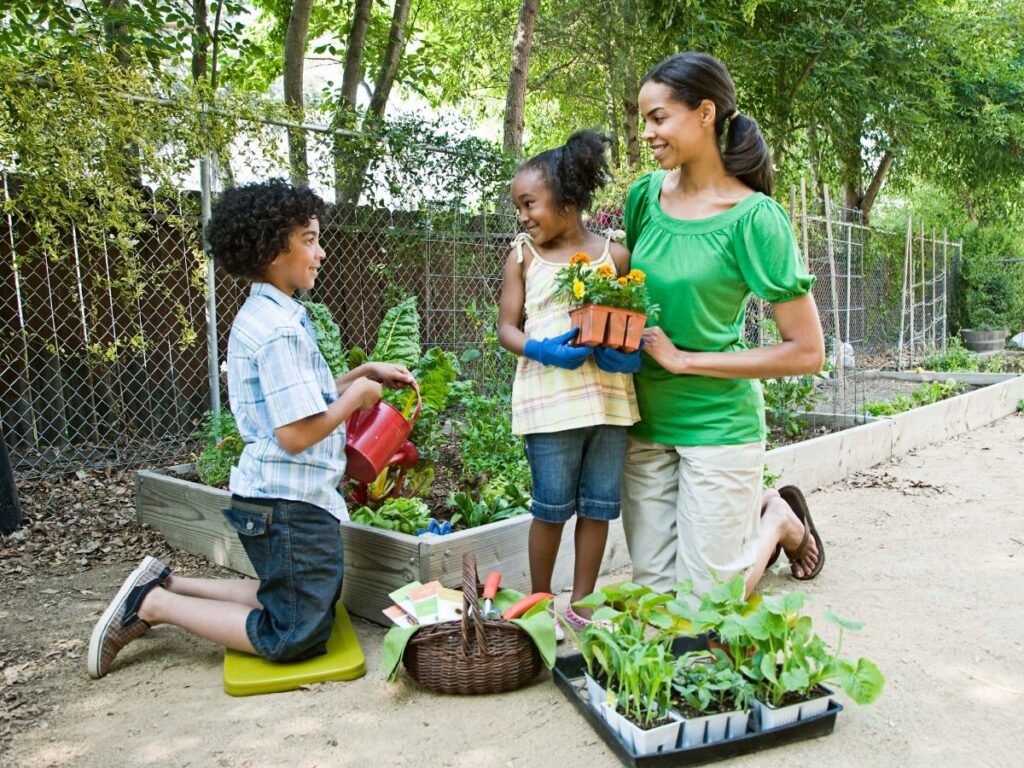
To review, Here are 7 steps to get your kids excited about eating vegetables:
- Set the Example
- Use Positive Messaging
- Visit a Farm
- Shop at a Farmer’s Market
- Plant a Garden
- Grow Microgreens Indoors
- Involve your Kids in Meal Prep
I hope these 7 steps have given you some great ideas around how you can encourage your child to eat vegetables.
I believe as parents, it is our job to help cultivate the connection between our kids and their food.
Start implementing these 7 steps today and help your kids develop a true love for vegetables that will be with them for life!
Want to learn how to grow microgreens at home? I’ve put together a complete course especially for busy moms! Growing microgreens is easy, fun and takes up very little time & space. The rewards, though, are huge!


